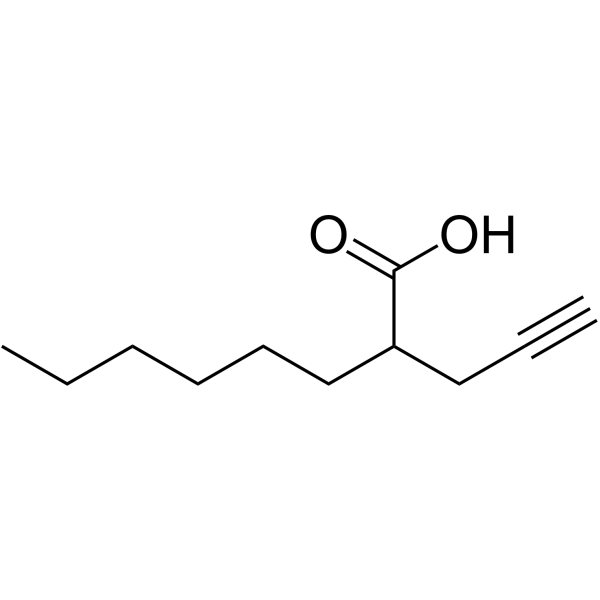
2-hexyl-4-Pentynoic Acid
CAS No. 96017-59-3
2-hexyl-4-Pentynoic Acid( —— )
Catalog No. M27428 CAS No. 96017-59-3
2-hexyl-4-Pentynoic Acid, a valproic acid (VPA) derivatives, is a potent and robust HDACs inhibitor with IC50 value of 13 μM.
Purity : >98% (HPLC)
 COA
COA
 Datasheet
Datasheet
 HNMR
HNMR
 HPLC
HPLC
 MSDS
MSDS
 Handing Instructions
Handing Instructions
| Size | Price / USD | Stock | Quantity |
| 50MG | 53 | Get Quote |


|
| 100MG | 86 | Get Quote |


|
| 200MG | 124 | Get Quote |


|
| 500MG | 236 | Get Quote |


|
| 1G | Get Quote | Get Quote |


|
Biological Information
-
Product Name2-hexyl-4-Pentynoic Acid
-
NoteResearch use only, not for human use.
-
Brief Description2-hexyl-4-Pentynoic Acid, a valproic acid (VPA) derivatives, is a potent and robust HDACs inhibitor with IC50 value of 13 μM.
-
Description2-hexyl-4-Pentynoic Acid, a valproic acid (VPA) derivatives, is a potent and robust HDACs inhibitor with IC50 value of 13 μM.
-
In Vitro——
-
In Vivo——
-
Synonyms——
-
PathwayCell Cycle/DNA Damage
-
TargetHDAC
-
RecptorBacterial
-
Research Area——
-
Indication——
Chemical Information
-
CAS Number96017-59-3
-
Formula Weight182.263
-
Molecular FormulaC11H18O2
-
Purity>98% (HPLC)
-
Solubility——
-
SMILESCCCCCCC(CC#C)C(O)=O
-
Chemical Name——
Shipping & Storage Information
-
Storage(-20℃)
-
ShippingWith Ice Pack
-
Stability≥ 2 years
Reference
1.I Messana, et al. An anthraquinone and three naphthopyrone derivatives from Cassia pudibunda. Phytochemistry. 1991;30(2):708-10.
molnova catalog



related products
-
Sodium Phenylbutyrat...
Sodium Phenylbutyrate is a transcriptional regulators that act by altering chromatin structure via the modulation of HDAC activity.
-
Valproic acid sodium...
A HDAC inhibitor that selectively inhibits the catalytic activity of class I HDACs, and induces proteasomal degradation of HDAC2.
-
BRD6688
BRD6688 is a selective HDAC2 inhibitor that acts by enhancing the learning and memory processes.



 Cart
Cart
 sales@molnova.com
sales@molnova.com


